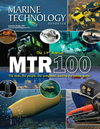
Page 49: of Marine Technology Magazine (September 2024)
Read this page in Pdf, Flash or Html5 edition of September 2024 Marine Technology Magazine
against the rotation experiences a slightly shorter path delay than the other beam, a phenomenon called the Sagnac effect.
The difference in phase shift between the two beams is used to estimate the rate of rotation. In an inertial navigation system, there will be three FOGs, each aligned orthogonally and com- bined with accelerometers to provide the sensed acceleration and rotation across six degrees of freedom.
The goal of minimizing size, weight, power and cost (SWaP-C) is driving much of the innovation underway with these systems.
Earlier this year, Exail released a new highly birefringent ? ber for military-grade FOGs, featuring what it claims is the highest birefringence and shortest beat length available in the industry (1mm at 633 nm). The inertial measurement unit in- cluding ? ber coil is now less than 30mm in diameter, and the material enhancements maximize the length of ? ber that can be used, thereby maximizing accuracy, whilst ensuring the mechanical reliability of the coils. This ? ber is available with a standard 80µm cladding but also with a smaller cladding of only 60µm for even smaller footprint gyros.
Exail sold the ? rst of its latest model, Phins 9 Compact, to
Bedrock for a new modular AUV designed for swift deploy- ment in geophysical surveys and monitoring. Equipped with multibeam echosounder, side scan sonar and magnetometer, the AUV boasts a 300m depth rating and 12-hour endurance surveying at three knots with all systems operational.
The Phins 9 Compact adds just 1.2kg to the payload and fea- tures a power consumption of less than 7W. It has a Doppler
A Ad dv va an nc ce ed d N Na av v vi i ig ga at ti io on n
Velocity Logger-aided position accuracy of heading accuracy ng Boreas A Series is designed fo fo fo fo o o o or r r r r r r surveying, mapping g a a an nd ng nd of 0.07° and pitch and roll accuracy of 0.01°. ppli navigation across subsea a a a, , , , , , , , m m m m m marine, land and air ir r a a a ap pplications.
The latest models added to Advanced Navigation’s DFOG range are the Boreas A Series, including A90 and A70. The
A Series is designed for surveying, mapping and navigation across subsea, marine, land and air applications. Both of the new models are strategic-grade inertial measurement units during erroneous measurements and post-measurement cor- (IMU) that contain ultra-high accuracy DFOG and high per- rections. The AI can then use this accumulated knowledge and formance closed-loop accelerometers. apply sensor error offsets that are tailored to the prevailing
All the measurements are combined into a proprietary neural conditions. This allows for a smaller FOG with reduced coil network algorithm which removes sensor errors and ? lters out length that can achieve the accuracy of one with a longer coil.
interference. Advanced Navigation’s sensor fusion algorithm “The coil lengths in our Boreas DFOG systems range from is more sophisticated than Kalman ? lters. Kalman ? ltering 300m on the smallest systems to 5km for the ultra-high accu- provides estimates for unknown variables that are primarily racy systems. The most popular unit we sell currently is based statistics-based. The sensor fusion approach is more accurate on 1,000m coil length. The coils are very precisely wound by at determining and removing sensor errors, which results in a specially designed robots at our high-tech manufacturing fa- higher performance navigation solution. cility in Sydney, using the quadrupole winding method,” says
The technologies that have been developed for the DFOG Xavier Orr, CEO and co-founder of Advanced Navigation.
include digital modulation techniques that allow in-run vari- Additionally, an optical chip is used to integrate the sen- able errors in the coil to be measured and removed from the sitive components into a single chip, thus removing all the measurements. The “learning” capabilities of the AI enable ? ber splices and reducing SWaP while increasing reliability it to accumulate sensor error data and associated conditions and performance. www.marinetechnologynews.com 49
MTR #7 (34-49).indd 49 10/3/2024 12:19:21 PM

 48
48

 50
50
